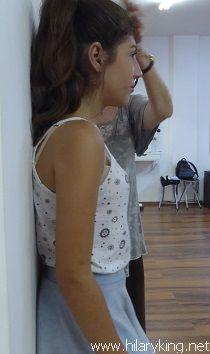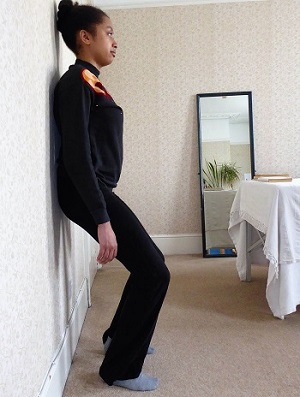Alexander Technique Wall Work is an Exploration of Movement
Alexander Technique Wall work is a procedure you can begin to use to explore your movement habits. Practise this with awareness and resist the temptation just to turn it into an exercise. This is not like doing a wall squats exercise.
Alexander Technique wall work is an exploration. You can use it to learn a lot about your body use whilst making a movement. It can also help you reduce tension and ease backpain. The procedure seems very simple but it is easy to let mis-use and distortion creep in and we don’t want you to practice unhelpful habits! So it is important to try this with your Alexander teacher, before exploring it on your own.

Hilary working with a pupil, doing Wall Work
Developing Awareness
Using the wall allows you to have feedback about where and how your body is touching the surface. We can learn from this feedback. Does your back change as you move? Do you pull yourself off the wall, or twist, or push your back into the wall?
Want to use the Lying Down Procedure but can’t because of where you are? Try using wall work at work, or waiting at a bus stop for instance. (Don’t look like Baloo scratching his back against a tree! Just quietly lean against the surface and free up your back!)
Wall work is Useful During Pregnancy!
If you are over 28 weeks pregnant, the NHS advises you not to lie on your back, in order to protect the baby. So using the Lying Down Procedure is less advisable for anything but brief periods. However, wall work can offer many of the same outcomes and is safer to use.
I have worked with pupils during pregnancy and using wall work is extremely helpful in the later weeks. It can also help the mother to explore going down into a squat, which is very useful during childbirth.
Marjory Barlow, F M Alexander’s niece and first generation teacher stated:
“FM had people working against the wall in the first training course. He used to say that the wall serves the same purpose as the table – an objective criterion, only in the vertical.”
Avoid End-gaining!
This is not about seeing how many times you can go up and down the wall, or how long you can hold the position. Neither is it about how far you can bend or slide down into a squat. Wall work is used to help you notice which unhelpful habits come into play during movement. When you learn about HOW you habitually tend to move, the more choice you have about how you perform activities.
The Wall Work Procedure
You need a smooth, flat surface such as a wall, door or even a bus stop to lean your body against. As you practise the procedure, use the feedback you get from the wall surface to learn about what is going on in your body as you move. Do you notice twisting or arching, do you pull yourself off the wall, or push yourself back onto it for instance? What do you notice? If you notice your back is arched, do not push your back against the wall. Allow it to gently ease and be supported by the wall.
Remember to pause and inhibit at the start; say ‘no’ to rushing or forcing your movements; avoid falling into the trap of end-gaining and doing lots of deep bends without awareness; say ‘no’ to any habits of mis-use that you are aware of, or to any new ones that you discover whilst doing during the procedure.
Give yourself directions throughout all your movements during the procedure.

Place your feet as wide apart as your hips, with heels about 3″ from the wall
Your head is unlikely to touch the wall (although your hair might touch it). If it does, this suggests that you may be pulling your head back or retracting your chin stiffly. Free your neck and allow your head to ease forward and up, so the distance from the wall is about the same as the height of books you use for the Lying Down procedure.
While standing, allow your weight to be taken by the wall and become aware of which parts of your back are touching the wall. Usually, you will have your pelvis and shoulders touching the wall, with a small gap between the wall and your lower back when your legs are lengthened. However, sometimes this arch is exaggerated because lumbar muscles are contracted and shortened. Get to know your own body and habits. Notice how much of your back you are allowing to release towards the wall and how much you are holding away from the wall.
What does this tell you?
Have you tightened your neck? Is one side of your body pulling away from the wall in a twist? Is your lumbar region arched and the muscles tight? Can you feel easy movements in your ribs when you breathe? Or are you fixing your ribs so they barely move?
If you notice any twists, arches etc in your back, resist the temptation just to ‘fix’ it and ‘do‘ the change by pushing your back into a new position. Use the directions to free your neck and your back, gently letting go of any tensions that pull you off an even balance. Allowing a tiny change that you can maintain freely, is of more value than just pushing yourself into a new position – that will probably revert back to the old one, as soon as your attention moves elsewhere.
- When ready to bend your knees, pause, then move freely whilst giving directions. Let your knees release out and away from your hips and your back, which stays easing back towards the wall. Consciously control your movement, so that you slide a little way down the wall. Maintain a free neck, free your hips, knees and ankles. Allow your pelvis to move so that your coccyx drops downwards as your lower back releases. Your lumbar arch can begin to lengthen out and become more shallow or even disappear – as it does when you lie down in semi-supine.
- Do not bend your knees too far to begin with. Only go down to where your thighs are parallel to the floor. As you move, keep allowing your head to direct forward and up, so that you maintain an upward flow through your body even though you are sliding down the wall.
Pause briefly with your knees bent and keep giving yourself directions. Refuse to tighten anywhere in order to hold the position. Allow yourself to breathe freely
What do you notice?
Is your back free and lengthened or did you pull yourself into an arch or twist as you moved? Are your knees directing out and away from your hips with muscles lengthening over your toes? Or did you contract in towards yourself, making the bent-knee position uncomfortable to maintain for any length of time?
Unless you are just recovering from an illness or injury, you would be well to note Dr Barlow’s words in his useful description of using wall work ‘If you find this position tiring after quite a short time, then you are indeed in a mis-used state’ ~ The Alexander Principle – Wilfred Barlow – p 117.
- Before you straighten your legs again, pause, inhibit, think and give yourself directions. Take care not to push yourself upwards with your legs or pull your head back and over-arch your torso as you move.
- Keep reminding yourself to have a free neck and allow your head to lead you into the upward movement with ease, your legs following your head. Think your back back towards the wall – don’t just push it back as ‘doing’ will just curl your spine and contract your abdomen. Ease your heels towards the floor. Allow your back to keep freely lengthening.
What is your back like now?
As you straighten your legs a slight arch will return to your spine but your back can keep being free and more lengthened than before – but did you tighten and over-arch, pulling your back or pelvis away from the wall? Many people do so and this is one habit of mis-use that you can learn to let go of with this procedure.
The more you can notice about your tensions, distortions or lack of inhibition, the more information you have for when you explore the procedure another time. Keep inhibiting, keep directing, keep freeing yourself throughout the movements, both going down and up. It will gradually feel easier to do and you will be able to avoid pulling your body around as you move.
Remember: Pause and Inhibit ~ Think and Direct ~ Then Move